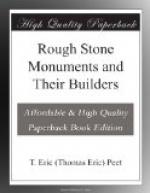Sir Norman’s reasoning has been severely handled by his fellow-astronomer Mr. Hinks, who points out that the direction chosen for the avenue is purely arbitrary, since Sidbury Hill has no connection with Stonehenge at all. Moreover, Sir Norman determines sunrise for Stonehenge as being the instant when the edge of the sun’s disk first appears, while in his attempts to date the Egyptian temple of Karnak he defined it as the moment when the sun’s centre reached the horizon. We cannot say which alternative the builders would have chosen, and therefore we cannot determine the date of building.
Sir Norman Lockyer has since modified his views. He now argues that the trilithons and outer circle are later additions to an earlier temple to which the blue-stones belong. This earlier temple was made to observe “primarily but not exclusively the May year,” while the later temple “represented a change of cult, and was dedicated primarily to the solstitial year.” This view seems to be disproved by the excavations of 1901, which made it clear that the trilithons were erected before and not after the blue-stones.
Nothing is more likely than that the builders of the megaliths had some knowledge of the movements of the sun in connection with the seasons, and that their priests or wise men determined for them, by observing the sun, the times of sowing, reaping, etc., as they do among many savage tribes at the present day. They may have been worshippers of the sun, and their temples may have contained ‘observation lines’ for determining certain of his movements. But the attempt to date the monuments from such lines involves so many assumptions and is affected by so many disturbing elements that it can never have a serious value for the archaeologist. The uncertainty is even greater in the case of temples supposed to be oriented by some star, for in this case there is almost always a choice of two or more bright stars, giving the most divergent results.
[Illustration: FIG. 2. Avebury and the Kennet
Avenue.
(After
Sir R. Colt Hoare.)]
Next in importance to Stonehenge comes the huge but now almost destroyed circle of Avebury (Fig. 2). Its area is five times as great as that of St. Peter’s in Rome, and a quarter of a million people could stand within it. It consists in the first place of a rampart of earth roughly circular in form and with a diameter of about 1200 feet. Within this is a ditch, and close on the inner edge of this was a circle of about a hundred upright stones. Within this circle were two pairs of concentric circles with their centres slightly east of the north-and-south diameter of the great circle. The diameters of the outer circles of these two pairs are 350 and 325 feet respectively. In the centre of the northern pair was a cover-slab supported by three uprights, and in the centre of the southern a single menhir. All the stones used are sarsens, such as are strewn everywhere over the district.




